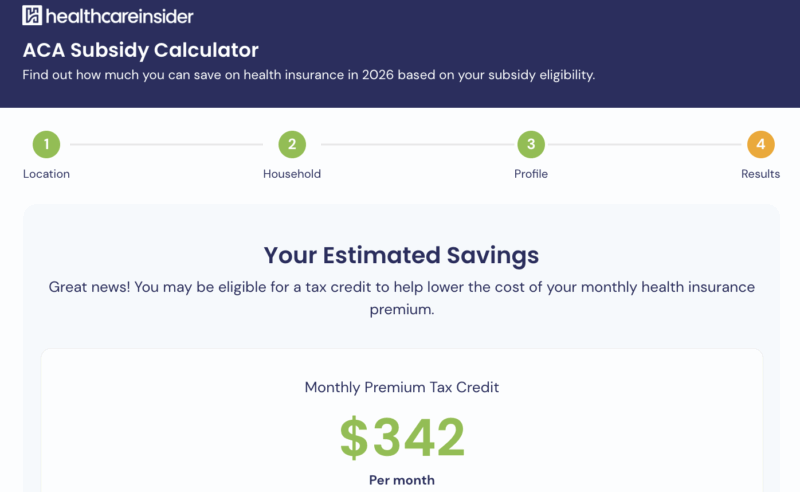Written by Michael LaPick
Healthcare Writer
Reviewed by Garrett Ball
Expert Reviewer
We want to help you make educated healthcare decisions. While this post may have links to lead generation forms, this won’t influence our writing. We adhere to strict editorial standards to provide the most accurate and unbiased information.
Editor’s Note: In February 2021, President Biden signed an executive order to re-open the federal and state Health Insurance Marketplaces for a Special Enrollment Period to aid the unemployed and uninsured. The enrollment period runs Feb. 15-May 15, 2021.
The American Rescue Plan Act was signed into law in March 2021. It expands premium tax credits, allowing more Americans to qualify for a health insurance subsidy for the next two years, along with many other provisions. For a full summary of the healthcare benefits you can receive from the law, visit our American Relief Plan outline.
How do you know if an insurance plan is an Affordable Care Act (ACT or Obamacare) plan? It’s easy to find out. All ACA plans must meet certain requirements, so they have some things in common.
To determine whether your health insurance plan is an ACA plan, simply follow the steps below.
1. Look for the Metal Level
Every ACA plan has a metal in its name. For example, say you have a plan named “Sendero Classic Silver.” Sendero is the insurance company, and Silver is the plan’s metal level.
While all Obamacare health insurance plans include certain benefits, how much the insurance company pays for your healthcare costs varies. Every plan falls into one of four metal levels, categories that help you determine the percentage of costs a plan will pay. Metal levels include Bronze, Silver, Gold, and Platinum.
The system basically is set up so that the cheaper the metal, the less expensive the plan’s monthly premiums. But these plans also make you pay a higher percentage of your medical bills. This means that Bronze plans typically have the lowest premiums, which is the amount you pay each month to stay on the plan, but the highest out-of-pocket costs when you need medical care or prescriptions. Platinum plans have the highest premiums, but you pay the least out of pocket.
Below is a breakdown of the average percentage of healthcare costs covered by each metal plan.
| Metal Level | What Insurance Pays, What You Pay |
| Bronze | Insurance pays: 60%, you pay: 40% |
| Silver | Insurance pays: 70%, you pay: 30% |
| Gold | Insurance pays: 80%, you pay: 20% |
| Platinum | Insurance pays: 90%, you pay: 10% |
2. Look for the Essential Health Benefits
All Obamacare plans include ten essential health benefits. These are categories of health services that must be covered under the Affordable Care Act.
Additionally, these benefits have no annual or lifetime limits, which means there is no cap on coverage for these services.
You can find out if your plan covers these by reviewing your Summary of Benefits and Coverage.
3. Check for Premium Tax Credits and Cost-Sharing Reductions
If you receive automatic financial help to pay for your coverage, you probably have an Obamacare plan. The ACA lets plan members apply for two types of assistance: premium tax credits and cost-sharing reductions.
A premium tax credit, also known as a subsidy, lowers the amount you pay each month for your plan. How much you save will depend on your annual income and the size of your household. If your plan has a discount each month, it is likely you have Obamacare coverage.
In 2021, the American Rescue Plan increased the amount of subsidies and expanded who could receive them for two years.
A maximum income cap to receive the premium tax credit was removed (previously, four times the federal poverty level).
The government also lowered how much you were expected to spend on health insurance (from 2% to 9.83% of your annual income to 0% to 8.5%). If the cost of a benchmark plan (second-cheapest silver plan in your area) costs more than a certain percent of your annual income, you qualify for subsidies.
A cost-sharing reduction is a discount that lowers the amount you have to pay for deductibles, copayments and coinsurance. Your income level and size of your household will also determine whether you qualify for these additional savings. But you must enroll in a silver plan to qualify for a cost-sharing reduction.
Even if you don’t receive financial help, you have an Obamacare plan if it has a metal level and covers the 10 essential health benefits.
Obamacare Plan FAQs
Now that you know the types of insurance plans under Obamacare, let’s take a look at some of the most common questions people ask about them.
When Do Obamacare Plans Start?
You can generally join Obamacare during the Open Enrollment Period from November 1st to January 15th each year. If you buy a plan during this time, your coverage will start on January 1st.
Can You Change Plans Under Obamacare?
You can change your Obamacare plan during the annual Open Enrollment Period. You won’t be able to change your plan outside this timeframe unless you qualify for a Special Enrollment Period.
To qualify for a Special Enrollment Period, you must experience a qualifying life event such as losing your health coverage, moving, being a survivor of domestic abuse, getting married, or having a baby. You have up to 60 days before and 60 days after the life event to change your insurance plan.
Can You Buy a Health Plan that Isn’t Obamacare?
You can buy a plan that isn’t Obamacare at any time. You don’t have to wait for open enrollment.
A few alternatives to Obamacare include short term health insurance, faith-based plans, and fixed-indemnity plans. While these plans are typically cheaper, they don’t offer the same comprehensive coverage. As a result, some states don’t consider them to be full health insurance and you can face a state tax penalty when you file your tax returns for not having medical coverage. The Trump administration repealed the federal penalty for not having insurance, but some state penalties are still in place. Also be aware that you can be denied coverage by these plans if you have a pre-existing condition.
How the Affordable Care Act Changed Healthcare
Today, most individual and employer-sponsored health plans meet ACA standards. This means most health plans include all 10 essential health benefits and cover preexisting conditions. They all work in the same basic way.
This wasn’t the case before the ACA healthcare reform. In some cases, people would find out after they became ill or were injured that many services weren’t covered. Whole sections of medical care, like maternity, were sometimes omitted from coverage.
To be safe, if you’re buying your own health insurance, an ACA plan is likely your best choice for coverage. Although other plans are available, you won’t get as many benefits and could be denied coverage for a pre-existing condition. Looking for an ACA plan or curious how much subsidies you may qualify for? Try our calculator tool to find out.
Thank you for your feedback!


 by
Garrett Ball |
Updated on
January 8, 2026
by
Garrett Ball |
Updated on
January 8, 2026 




